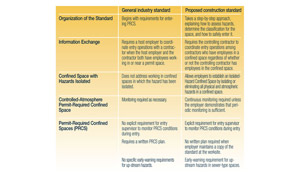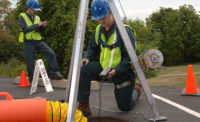
|
|
This chart outlines the key differences in regulatory provisions between the two standards. |
A bit of history
In 1993, OSHA issued a rule to protect employees who enter confined spaces while engaged in general industry work (29 CFR 1910.146). This standard has not been extended to cover employees entering confined spaces while engaged in construction work because of unique characteristics of construction worksites. Following discussions with the United Steel Workers of America that led to a settlement agreement regarding the general industry standard, OSHA agreed to issue a proposed rule to protect construction workers in confined spaces. The proposed rule was published in November 2007.
A predicted powerful impact
At the time the proposed rule was published, approximately 20,000 construction establishments had employees entering at least one confined space as defined by the proposed rule, OSHA said. There were an estimated annual total of 641,000 confined spaces, and about half of these would be considered permit-required confined spaces under the proposal. OSHA estimated that each year there are 6.44 fatalities and 967 injuries experienced by employees working in confined spaces on construction sites. OSHA predicted that the proposed rule, when implemented properly by employers, would reduce the average number of fatalities and injuries in confined spaces in the construction industry by about 90 percent (6 fatalities and 880 injuries prevented annually).
Construction- specific issues
OSHA does not believe that the general industry standard addresses adequately the unique characteristics of confined spaces in construction. Here’s why:
- The construction industry experiences higher employee turnover rates than general industry, with construction employees more often working at multiple worksites performing short-term tasks.
- Unlike most general industry worksites, construction worksites are continually evolving, with the number and characteristics of confined spaces changing as work progresses.
- Multiple contractors and controlling contractors are found more often at construction worksites than at general industry worksites.
- OSHA believes many contractors who perform construction work in sewer systems are unfamiliar with the hazards associated with these worksites. Therefore, OSHA placed more emphasis in this proposed standard on assessing hazards at sewer worksites than it did in the general industry confined-spaces standard.
What’s the difference?
While OSHA recognizes that a number of requirements of the proposed standard for confined spaces in construction duplicate, or are similar to, the provisions of the general industry standard for permit-required confined spaces, there are significant differences.




